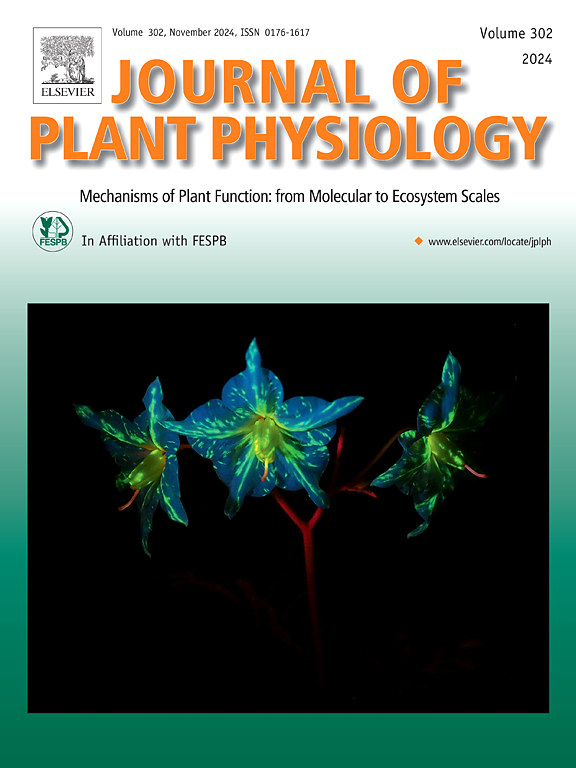Overexpression of AtBES1D in tomato enhances BR response and accelerates fruit ripening
IF 4.1
3区 生物学
Q1 PLANT SCIENCES
引用次数: 0
Abstract
Brassinosteroids (BRs) are essential plant hormones that regulate growth and development, with BRI1-EMS SUPPRESSOR 1 (BES1) and BRASSINAZOLE-RESISTANT 1 (BZR1) serving as central transcription factors in BR signaling. However, the role of BES1 in regulating tomato fruit ripening remains poorly understood. Here, we generated three independent transgenic tomato lines overexpressing Arabidopsis thaliana BES1D (AtBES1D). Overexpression of AtBES1D enhanced BR responses, as demonstrated by enhanced responsiveness to BRs and reduced sensitivity to the BR biosynthesis inhibitor brassinazole (BRZ). AtBES1D-transgenic tomato plants exhibited pleiotropic phenotypic alterations, including stunted growth, curled leaves, suppressed root elongation, delayed flowering, accelerated fruit ripening, and diminished fruit size, weight, and seed number. In addition, AtBES1D transgenic fruits exhibited upregulated expression of ethylene-related genes (ACS4, NR, ERF1, ERF4, E4, and E8) and ripening regulators (RIN, TAGL1, FUL1, FUL2, and PG). Chromatin immunoprecipitation sequencing (ChIP-seq) identified 1757 AtBES1D target genes, predominantly enriched in plant hormone signaling, transcriptional regulation, and metabolic pathways. Collectively, these findings establish AtBES1D as a multifunctional regulator modulating vegetative development, reproductive transition, and fruit ripening in tomato. AtBES1D likely promotes fruit ripening and improves fruit quality by modulating BR signaling, ethylene pathways, transcription factors, and metabolic processes.
AtBES1D在番茄中过表达可增强BR反应,加速果实成熟
油菜素内酯(Brassinosteroids, BRs)是调控植物生长发育的重要激素,其中BRI1-EMS SUPPRESSOR 1 (BES1)和brassinazol - resistant 1 (BZR1)是br1信号转导的中心转录因子。然而,BES1在调节番茄果实成熟中的作用仍然知之甚少。本研究构建了3个独立的过表达拟南芥BES1D (AtBES1D)的转基因番茄品系。AtBES1D的过表达增强了BR反应,如对BR的反应性增强和对BR生物合成抑制剂brassinazole (BRZ)的敏感性降低所示。atbes1d转基因番茄植株表现出多效性表型改变,包括生长发育迟缓、叶片卷曲、根伸长抑制、开花延迟、果实成熟加速、果实大小、重量和种子数量减少。此外,AtBES1D转基因果实的乙烯相关基因(ACS4、NR、ERF1、ERF4、E4和E8)和成熟调节因子(RIN、TAGL1、FUL1、FUL2和PG)表达上调。染色质免疫沉淀测序(ChIP-seq)鉴定出1757个AtBES1D靶基因,主要富集于植物激素信号、转录调控和代谢途径。综上所述,这些发现表明AtBES1D是番茄营养发育、生殖转变和果实成熟的多功能调节剂。AtBES1D可能通过调节BR信号、乙烯通路、转录因子和代谢过程来促进果实成熟和改善果实质量。
本文章由计算机程序翻译,如有差异,请以英文原文为准。
求助全文
约1分钟内获得全文
求助全文
来源期刊

Journal of plant physiology
生物-植物科学
CiteScore
7.20
自引率
4.70%
发文量
196
审稿时长
32 days
期刊介绍:
The Journal of Plant Physiology is a broad-spectrum journal that welcomes high-quality submissions in all major areas of plant physiology, including plant biochemistry, functional biotechnology, computational and synthetic plant biology, growth and development, photosynthesis and respiration, transport and translocation, plant-microbe interactions, biotic and abiotic stress. Studies are welcome at all levels of integration ranging from molecules and cells to organisms and their environments and are expected to use state-of-the-art methodologies. Pure gene expression studies are not within the focus of our journal. To be considered for publication, papers must significantly contribute to the mechanistic understanding of physiological processes, and not be merely descriptive, or confirmatory of previous results. We encourage the submission of papers that explore the physiology of non-model as well as accepted model species and those that bridge basic and applied research. For instance, studies on agricultural plants that show new physiological mechanisms to improve agricultural efficiency are welcome. Studies performed under uncontrolled situations (e.g. field conditions) not providing mechanistic insight will not be considered for publication.
The Journal of Plant Physiology publishes several types of articles: Original Research Articles, Reviews, Perspectives Articles, and Short Communications. Reviews and Perspectives will be solicited by the Editors; unsolicited reviews are also welcome but only from authors with a strong track record in the field of the review. Original research papers comprise the majority of published contributions.
 求助内容:
求助内容: 应助结果提醒方式:
应助结果提醒方式:


